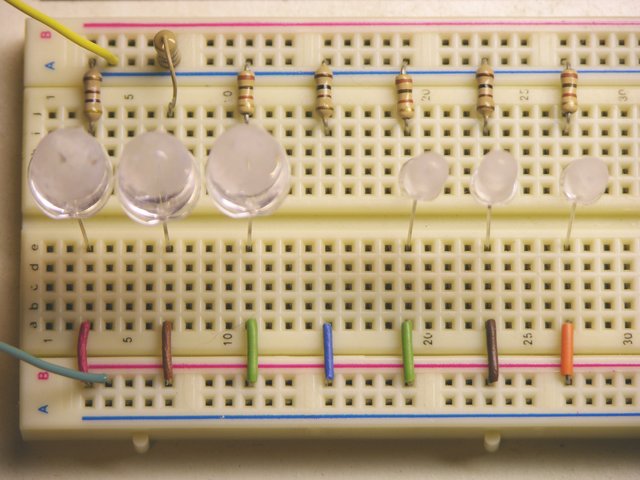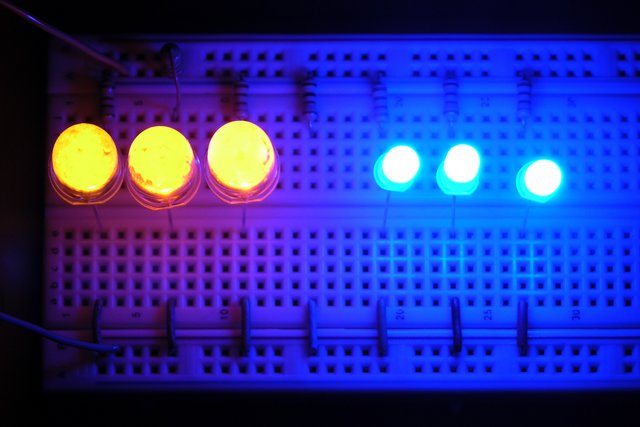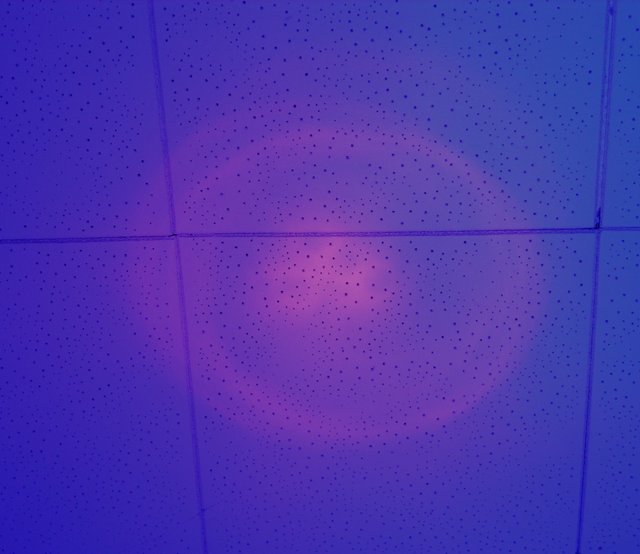I’m still interested in building a sunrise alarm clock, to gradually lighten the bedroom up to full daylight brightness when it’s time for me to wake up. I’d enjoy making it with LEDs, and a blog reader suggested I check out some yellow LEDs from this eBay seller.
They had fifty 10mm 60,000 mcd yellow LEDs for $6.98 plus $8.98 shipping and $2.00 insurance, so $17.96 for the lot or 36¢ each. Seemed very reasonable, and I was the only bidder on that batch, so I won the auction.
The LEDs arrived, and they’re the first 10mm LEDs I’ve bought, and they’re huge. But I put them in my LED tester, and they don’t seem that bright, even at 50 mA. So tonight I put them in a breadboard with 100Ω resistors and cranked up my variable bench power supply. They still don’t seem that bright.
Here’s the layout, so you can see I’m not lying and using different resistor values for different LEDs. The LEDs on the left are the 60,000 mcd yellows, and the ones on the right are the 5mm 10,000 mcd blues I’m using in the LED clock.
The yellows are a little more directional than the blues, which was making comparison difficult, so I scuff-sanded all of them to get a frosted, diffuse effect and level the playing field. The blues are pretty clearly brighter.
Here’s the ceiling above the breadboard. The yellows are still more directional even after frosting — the whole ceiling is bathed in pleasing, blue light with only a small patch of slightly brighter yellow in the center.
I know that candelas are a measure of brightness within the coverage pattern of a directional light source, whereas lumens are a measure of total light output. Here’s my favorite mcd and viewing angle to lumen calculator, which makes it easy to convert. The seller’s information for the yellows says they have a 10° viewing angle, and I should have thought more carefully about its impact before buying.
At 3 lumen each, and with a 60W incandescent outputting about 800 lumen, I’m probably not going to be able to use these to simulate full daylight. I’ve been starting to consider using dimmable fluorescents instead, in spite of the hassle of having to build an enclosure to protect the bulbs.
I wonder what application only needs a 10° viewing angle.
Lesson: Always check viewing angle and lumen output of LEDs before buying.



Might check out these fellows from sparkfun:
http://www.sparkfun.com/commerce/product_info.php?products_id=602
They are expensive, but *very* bright. How many volts are you using to drive the LEDs? I know LEDs like the Luxeon need heatsinks and often a PWM controller is used to regulate power to the LED.
Paul, I already have some Luxeon IIIs and a V. Yes, they’re extremely bright. But as you note, the heatsink and the need for current control make them a bit clumsier than traditional LEDs.
In the pictures above, I was running about 7V through all the LEDs, which is 50mA order of magnitude. Earlier I had run them up even higher, probably to or beyond 100mA, briefly.
Oh, and then there was the yellow one I burned out because I was using a 100Ω inductor instead of resistor. (Well, it looked like a resistor — even in a tan package — just a little lumpier.) It glowed a strange orangey-red color as it was dying.
Don’t forget to factor in the fact that the sensitivity of the human eye drops off towards the blue end of the spectrum. Additionally, as people age, the lens of their eye tends to yellow, and this may decrease the sensitivity to blue even more. Of course, that doesn’t explain why the blues look brighter than the yellows. :-/
You might also consider some of the super-efficient red LEDs.
As for diffusing the cases, in an extreme case, I’ve even been known to take to the epoxy case with a rasp and turn the dome into a flat surface, which broadens the viewing angle significantly. Don’t go too deep with this, since you don’t want to risk cutting the bond wire to the top of the chip. But, it can be done (I’ve also drilled holes into the epoxy in order to glue a fiber optic into an LED (not that I’d recommend this for the sunrise clock idea).).
As for the clock idea, I’ve long thought about building a clock which, when the alarm goes off, it gradually increases the room lighting, simulating the natural increase of light at sunrise. However, I haven’t yet done anything with the idea yet. My preferred implementation would probably be to use a microcontroller to build the clock with, and have that vary the triggering of a triac which controls an incandescent lamp (Yeah, remember all about safety with regards to isolation from the AC line and such.). I know that incandescents are much less efficient than fluorescents (regular or CFLs), but it might be easier to building the circuit using an incandescent. The other approach might be to use a fluorescent and pulse width modulate the power to it (But, that will get tricky, what with having to factor in ballasts, and the fact that glow discharge lamps are extremely nonlinear devices; Plus fluorescent lamps are even more nonlinear since the glow discharge characteristics depend upon the temperature of the gas and how much of the Mercury has vapourized).
Dave
P.S. Welcome to the wonderful world of optics. I used to work in an opto-electronics lab, and it’s an eye opening experience (if you’ll pardon the pun!).
Oh, while we’re talking about clocks, here’s another idea for you. I’d like a clock that displays the time serially via a single LED (or Neon, or…). The reason is that I’m extremely near-sighted [1], so much so that I can’t read even a huge clock at night without my glasses. But, I can see a light (even if it does appear exceptionally fuzzy), and I could count the blinks to tell what time it is.
[1] How near-sighted? I once went into a place that makes glasses in one hour (while you wait). When I handed my prescription to the optician, she read it, and then screamed (in front of a packed waiting room) “OH MY GOD! We can’t make these!”. Now that’s near-sighted!
Another variation would be to use different colour LEDs (Think of sort of a
binary display clock with the different binary digits represented by different coloured LEDs).
Anyway, just some fun ideas to think about.
Dave
Blue appears brighter because it’s a shorter wavelength and scatters more efficiently. Think of why the sky appears blue… Rayleigh and all that.
I thought about making a slowly undimming light controlled by a timer for a sunrise simulator. After reading this i think LED’s may be the way to go as long as they are bright enough, gets away from using mains.